Southwest MN IPM STUFF
All the pestilence that’s fit to print
IPM STUFF 2024-1
3/5/2024 | Volume 27 number 1b
This newsletter and the advice herein are free. You usually get what you pay for.
Crop weather
Rainfall, air and soil temperatures, degree-days, soil moisture, and other current and historical weather data for the University of Minnesota Southwest Research and Outreach Center (SWROC), a little spot about two miles west of Lamberton, MN, can be found at https://swroc.cfans.umn.edu/weather.
2024 IPM Stuff Corn Pest Forecast
My predictions on crop pests are mostly for the southwest quarter of the state but may apply to crops elsewhere. Here are some thoughts on the potential for several key corn insects.
European corn borer
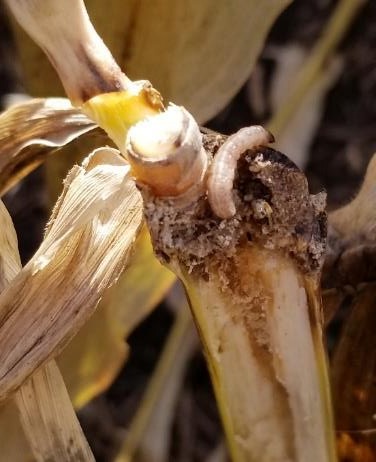
- From its arrival here in the 1940s, until the adoption of Bt corn in the mid-1990s, the European corn borer (ECB) was the most widespread and destructive pest of Minnesota corn. Some of you can remember messes of broken and tangled stalks, and dropped ears that followed the feeding of ECB larvae in a “bad corn borer year”.
- ECB are well adapted to surviving Minnesota winters. Full-grown larvae diapause (suspend development) and overwinter in corn stalks, corn cobs, and cornfield residue. Larval development resumes and pupation occurs when spring temperatures reach 50o F.
- Single generation (univoltine) ECB predominates in northern Minnesota. Their larvae require more time for pupation and moth emergence than the two-generation (bivoltine) borers that are historically more common in the south. Corn borer development and management timing can be predicted by degree-day models (degree day models for select insect pests in the Midwest region).
- Although the larvae usually winter well, weather can still impact ECB survival. Cold weather hinders moth activity, low humidities can desiccate eggs, and heavy rains can drown small larvae in the corn whorl.
- ECB populations are currently low in Minnesota, but they are not extinct. A crop consultant and I recently visited a southern Minnesota corn field that had been planted to a non-Bt hybrids for several years. The numerous larvae that survived the 2023-24 winter well were unaware that many would soon be donating their lives to science, i.e., ECB genetic research in the UMN lab of Dr. Fei Yang.
- When scouting. pay close attention to fields in areas where Bt has not been used in previous corn crops. Focus initial scouting on the tallest corn for the 1st generation, and later silking corn for 2nd generation bivoltine larvae. Wandering univoltine females are attracted to corn near tassel emergence to lay eggs.
- While Bt hybrids have helped maintain low overall ECB populations statewide, the potential for Bt resistance is an increasing concern. The discovery of resistant populations in Canada reinforces that concern and the need to be vigilant. For more information see European corn borer - Old pest new problems
True armyworm (Mythimna unipuncta)
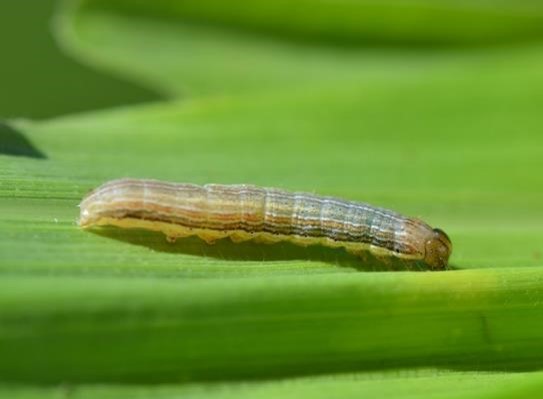
- The true armyworm (TAW) cannot overwinter in Minnesota. The moths migrate here on sustained southerly winds each spring. The moths can take advantage of low-level jet streams to cover long distances quickly.
- Significant TAW infestations occurred in 2023, particularly in SE Minnesota.
- TAW larvae feed on grasses and grass crops such as corn and wheat.
- Infestations are sporadic, depending on when and where moths arrive. The timing and extent of problems from this insect will depend on 1) The winter survival and population density of populations in the south, 2) The proper weather systems occurring when and where moths are ready to migrate, and 3) Crop and weather conditions where migrating moths arrive.
- Egg-laying TAW moths look for dense grasses to lay eggs. Focus your initial scouting on lush pastures, winter cereals and spring planted cereals, especially where lodged. Most plant material is consumed by late-stage larvae. Find infestations early. Crops can disappear quickly, seemingly overnight. When armyworm caterpillars have consumed the food in the area they hatched, they will move in groups looking for food.
- Uncontrolled grass weeds and late-terminated cereal rye cover crops can make corn more attractive to moths. Often, these infestations go unnoticed until the weeds or rye are terminated.
- Here are some thoughts on TAW management options if you decide to plant corn into a cereal rye cover crop:
- Terminate rye very early in spring before moths arrive (this has agronomic benefits too).
- Plant a hybrid containing the Vip3a protein (e.g., Viptera, Trecepta, VT4 Pro)
- Scout at rye termination, and weekly for two weeks when corn has emerged.
- Apply a labeled insecticide corn economic threshold is reached (2 larvae/plant), or when larvae are small and very numerous.
- Insecticides need good coverage to be effective on larvae on the soil below a dense canopy.
- Springs with strong southerly winds and numerous thunderstorms often result in TAW problems later. The weather systems bring moths into Minnesota and the rainfall encourages the grass growth providing good larval habitat.
- The Minnesota IPM program uses blacklight and pheromone traps to track the arrival of moths. We will know what type of armyworm year we will have by late June or early July.
- See armyworm in corn for more information.
Black cutworm
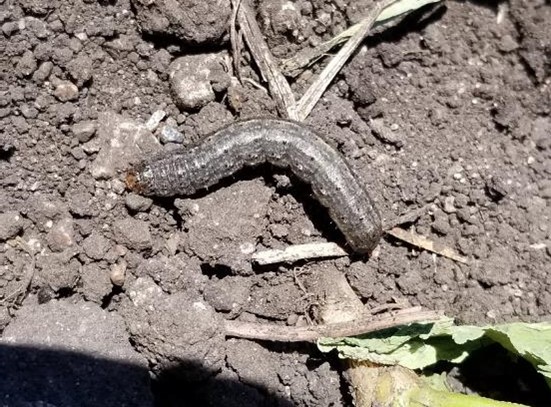
- The black cutworm (BCW) is another corn insect pest that migrates into Minnesota each spring. The moths make use good use of the spring low-level jet streams that develop in the plains. Their migrating behavior is similar to the armyworm. However, BCW larvae have a wider host range than their armyworm cousins, feeding on many grass and broadleaf species, including corn, soybeans and sugarbeets.
- A network of BCW mating pheromone traps monitors the arrival of moths, helping predict the location and timing of potential BCW infestations. The trapping results are posted weekly at the black cutworm reporting network.
- Female moths are attracted to areas with fall or early spring emerging weeds. Low-lying areas are often selected for egg laying. Corn planted after the moths arrive is at greater risk. Focus your initial scouting efforts there.
- Feeding by late stage BCW larvae kills corn if plants are cut at, or below, the growing point. The lost stand can lead to potential yield loss or a need for replanting.
- Black cutworm damaged several fields in 2023.
- See black cutworm on corn for more information on biology, scouting, and management.
Corn rootworms
Although your corn fields may have other insect issues in 2024, rootworms are currently the pest most threating to Minnesota corn production. Common questions include: What are rootworm populations doing? Are there weather effects that can help reduce them?
- Western corn rootworm (WCR) and northern corn rootworm (NCR) both occur in Minnesota. Their basic biology is similar.
- In late summer, the female rootworm beetle lays her eggs in the soil. These eggs must go through a resting stage (diapause) before they can hatch the following spring.
- WCR eggs resume development as temperatures warm in the spring and begin hatching once 380-degree days (base 52o F) are accumulated. For southern Minnesota, this typically occurs in early June. 50% hatch occurs between 684 and 767 degree days. Coincidently, one of the species of firefly often appears around this same time in southern MN.
- Only the roots of corn and a few other grasses are hosts for rootworm larvae. Until the newly hatched larvae find and tunnel into a root, they are susceptible to drowning in wet soils. Drowning a young corn crop might provide excellent, but expensive, control of rootworm larvae.
- Yield loss from rootworm injured corn roots is often worse in dry years.
- The larvae pupate after going through three larval stages. Both western and northern corn rootworm beetles begin to emerge around the same time. Mating occurs at or soon after emergence.
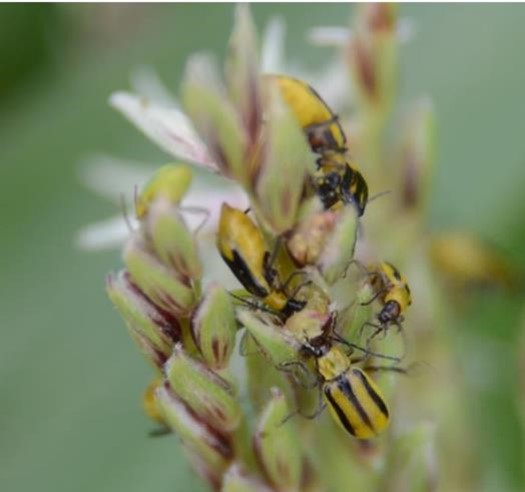
Western corn rootworm beetles 2023 WCR corn beetle populations and root injury in research plots at the UMN SWROC were similar or slightly lower than in 2022. I suspect that this reflects southern Minnesota populations in general.
- WCR is a significant pest of and tends to dominate in southern Minnesota continuous corn. However, these WCR populations are still susceptible to crop rotation. One crop year out of corn is still the best way to control very high WCR populations.
- WCR eggs are susceptible to very cold winter soil temperatures. Winter mortality can increase with soil temperatures below 20o F and increases with longer cold temperature exposure and lower temperature. Cold temperatures were likely responsible for a short-term collapse of WCR populations after the winter of 2013-14. Even with little snow cover at the SWROC, 2023-24 winter soil temperatures have remained above a level expected to cause significant egg mortality.
- Many WCR populations are resistant to one or more Bt-RW traits. When the WCR population is partially resistant, beetles developing from larvae exposed to Bt trait(s) may emerge later. Fields with Bt resistance may see beetle emergence occur over an unusually long time.
- NCR populations had been low since 2006 but increased dramatically in 2023. As observations of injured roots and large numbers of beetles began to increase, concerns over this species also increased from 2021 through 2023.
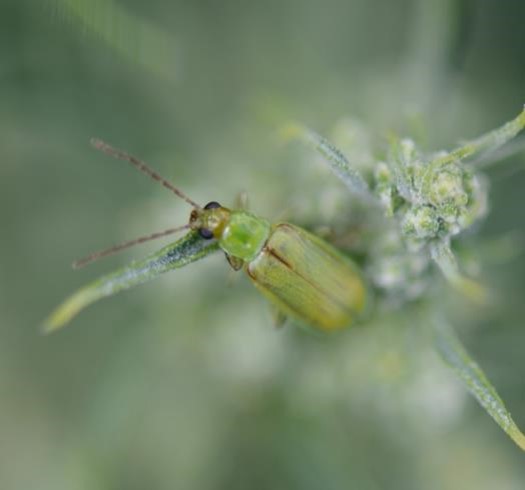
Northern corn rootworm beetle Historically, NCR are the predominant species in MN and still predominate in northern Minnesota continuous corn.
- Although they do well in continuous corn, some NCR have also to rotated corn. A percentage of the NCR population’s eggs do not break diapause and hatch the following year. By delaying the hatch for a year, the larvae will find themselves with a corn host if the field is continuous corn or a corn/soybean. A smaller percentage of eggs might delay hatching for two, three, and even four years. This “extended diapause” trait caught many growing rotated corn by surprise.
- The percentage of eggs that display this extended diapause trait varies by NCR population in the area. To make things even less predictable, some research has suggested that in addition to genetics, there may be a temperature component influencing termination of diapause.
- NCR populations, and the prevalence of extended diapause, varies by geographic area and by field cropping history.
- NCR eggs are much more tolerant of cold temperature than those of the WCR. For example, in one study, when exposed to 0.5o F tempreatures,100% of WCR eggs died while 50 to 80% of NCR survived.
- NCR populations with increased survival on Bt traited hybrids have been found in ND, MN, and IA.
- Most extended diapause problem fields have been planted to hybrids without Bt-RW traits. However, the potential for Bt-resistant, extended diapause NCR makes things challenging and a bit depressing.
Happy trails,
Bruce
